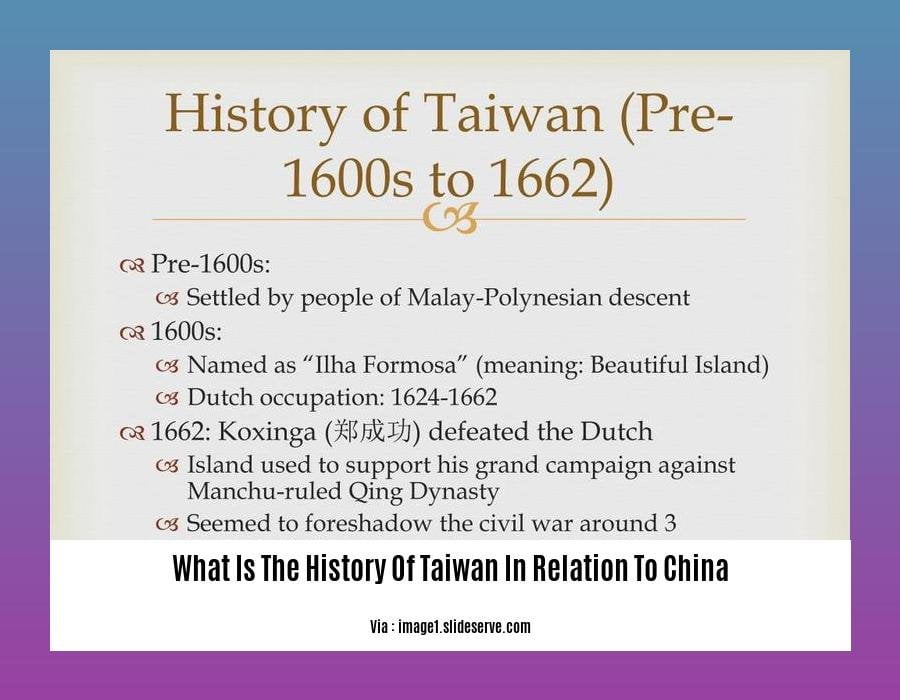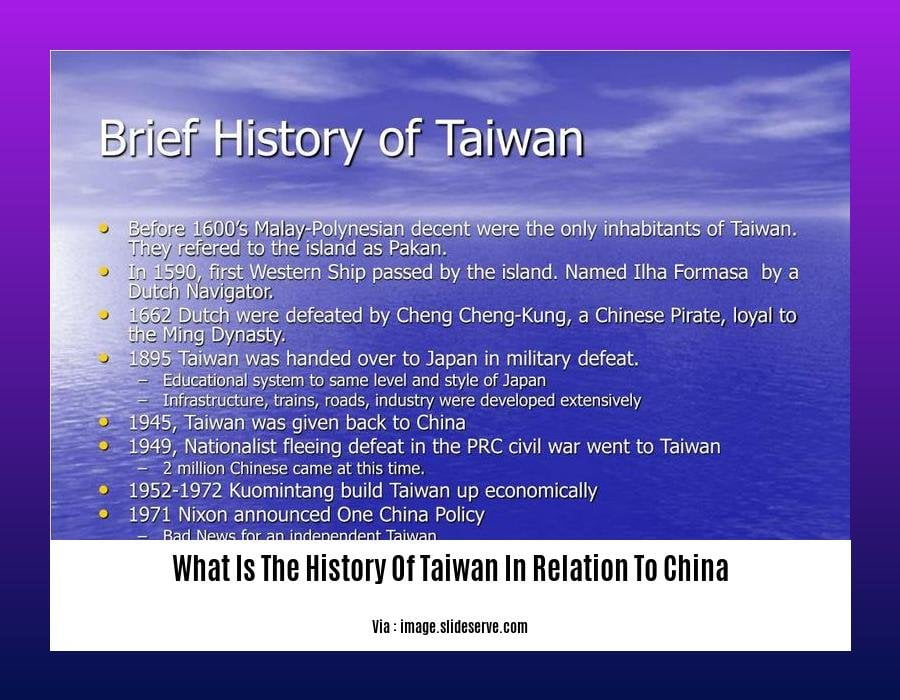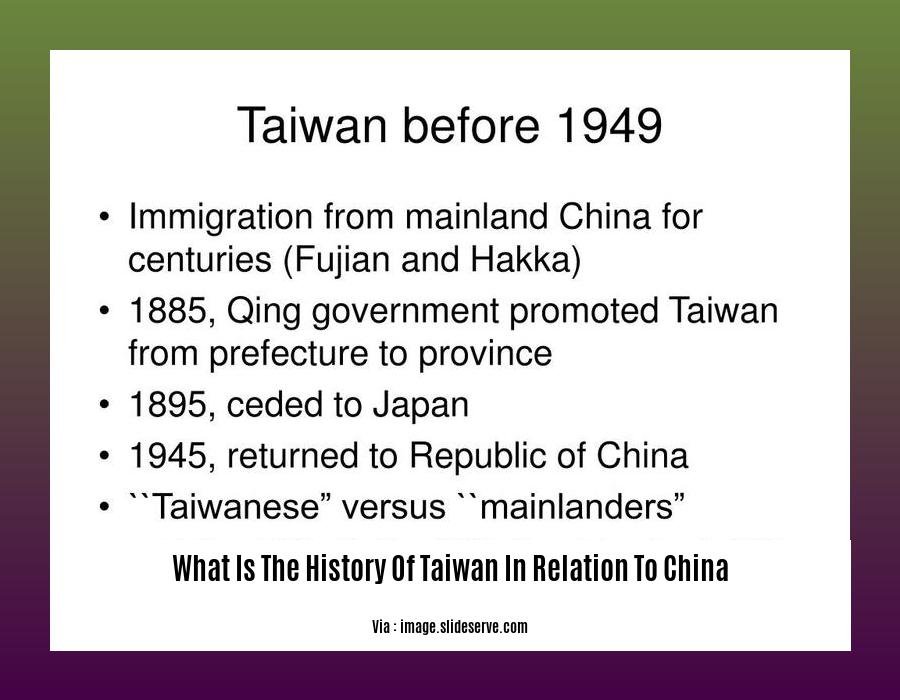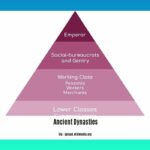What Is The History Of Taiwan In Relation To China?
The history of Taiwan in relation to China is complex and multifaceted, marked by centuries of political, economic, and cultural exchanges. Situated just off the coast of mainland China, Taiwan has been influenced by Chinese dynasties since ancient times. Over the centuries, it has served as a trading hub, a refuge for fleeing Chinese rulers, and a focal point of regional and international power struggles. The island’s relationship with China has undergone significant transformations, from being a tributary state to becoming a separate political entity during the 20th century. Today, Taiwan remains a contested territory, with complex political, diplomatic, and economic ties to China.
Key Takeaways:
- Ancient Inhabitants: 九個平埔族居住於台灣數千年。
- 明鄭時期: 1662 年,明鄭成功驅逐荷蘭勢力,將台灣納入中國版圖。
- 清朝統治: 台灣由清朝管轄,後在甲午戰爭中割讓給日本。
- 日本殖民: 二戰後,日本放棄對中國領土的控制,包括台灣。
- 國府遷台: 1949 年,共產黨奪取中國大陸,國民政府遷往台灣並定都。
- 中國立場: 台灣自 1949 年起由中華人民共和國治理,但北京視其為中國的一部分。
- 美中衝突擔憂: 部分專家認為美國和中國可能因台灣問題而爆發戰爭。
What Is The History Of Taiwan In Relation To China

Taiwan has a long and complex history with China. The island has been inhabited by indigenous tribes for thousands of years, but it was first brought under Chinese control in the 17th century.
Chinese Rule
In 1662, a Ming loyalist named Koxinga drove the Dutch out of Taiwan and established Chinese control over the island. Taiwan was then administered by the Qing dynasty until 1895, when it was ceded to Japan after the First Sino-Japanese War.
Japanese Rule
Japan ruled Taiwan for 50 years, during which time it implemented a number of policies designed to assimilate the Taiwanese people into Japanese culture. These policies included the forced teaching of Japanese language and culture, and the suppression of Taiwanese customs and traditions.
Post-World War II
After World War II, Japan relinquished control of Taiwan, which was then returned to China. However, the Chinese civil war soon broke out, and the Nationalist government was defeated by the Communists. The Nationalists fled to Taiwan, where they established a separate government.
Present Day
Taiwan has been governed independently of China since 1949, but Beijing considers the island to be a part of its territory. The two sides have never signed a peace treaty, and tensions remain high.
The history of Taiwan in relation to China is a complex and often contentious one. The two sides have a long history of conflict and mistrust, and the issue of Taiwan’s status remains unresolved.
Curious to know about the history of Tai Tam Country Park?
What is the history of Tai Tam Country Park? will help you gather all the information.Always wanted to know What Is The History Of Taiwan And China? Do you want to distinguish the real history from the fake one about Taiwan and China?
Click here to get to know every bit of it.Did you know What Is The History Of Tai Chi, the oldest internal Chinese martial art? Click on the link and read everything about it.
Japanese Rule of Taiwan
Before Imperial Japan’s arrival, Taiwan had been inhabited for millennia and briefly ruled by the Chinese.
From 1895 to 1945, Japanese Rule of Taiwan began a new era marked by distinct periods.
Three Policy Periods
- Military Suppression: Japanese efforts to quell resistance, from 1895-1915.
- Assimilation: Gradual introduction of Japanese customs and education, from 1915-1937.
- Japanization: Intensification of Japanese influence, marked by cultural erasure, from 1937-1945.
Government-General of Taiwan
The Japanese Rule of Taiwan was administered by the Government-General of Taiwan, the highest colonial authority.
Educational and Social Policies
- Education System: Established elementary schools that promoted Japanese language, culture, and Confucian ethics.
- Social Reforms: Targeted the “Three Vices” of opium, gambling, and prostitution for eradication.
Economic Impact
- Standardized Currency: Introduction of a unified currency and weights and measures.
- Agricultural Advancements: Boosted production and export of rice and sugar.
Key Takeaways:
- Japanese Rule of Taiwan spanned 50 years, from 1895 to 1945.
- Three Policy Periods shaped the colonial experience: military suppression, assimilation, and Japanization.
- Education and Social Reforms aimed to instill Japanese values and eradicate social ills.
- Economic Policies modernized Taiwan’s economy and boosted exports.
Sources:
Post-World War II Era and the Chinese Civil War

Key Takeaways:
- The Chinese Civil War was a conflict between the Nationalists and Communists that lasted from 1927 to 1949.
- The war began after the end of World War II and the collapse of the United Front between the two groups.
- The United States sent the Marshall Mission to mediate, but it failed to resolve the conflict.
- The Communists eventually defeated the Nationalists, and the People’s Republic of China was established on the mainland.
- The Nationalists retreated to Taiwan, where they continue to govern today.
The end of World War II marked a significant turning point in the Chinese Civil War. The war had been ongoing since the early 1920s, but it escalated significantly after Japan surrendered in 1945. The United States hoped to prevent a communist victory in China, and it sent the Marshall Mission to mediate between the Nationalists and Communists. However, the mission failed to achieve its objectives, and the war resumed in 1946.
The war was a brutal conflict, and it resulted in the deaths of millions of people. The Communists eventually gained the upper hand, and the Nationalists were forced to retreat to Taiwan in 1949. The People’s Republic of China was established on the mainland, and it has been the governing body of China ever since.
The Chinese Civil War had a profound impact on the history of China. The war led to the establishment of two separate Chinese governments, and it continues to be a source of tension between China and Taiwan.
Sources:
- Britannica:
- Oxford Research Encyclopedia of Social Work:
Modern Taiwan and Cross-Strait Relations
For centuries, Modern Taiwan and Cross-Strait Relations have been shaped by a complex interplay of political, economic, and social factors. Today, the relationship is characterized by both cooperation and tension.
Diplomatic Stance
Officially, Modern Taiwan maintains a position of “One China,” believing that Taiwan is a part of China, but under the ROC rather than the PRC. On the other hand, China adheres to a “One China” policy, claiming Taiwan as its territory that must be eventually reunited, even through military force. This political divide has led to strained diplomatic relations between the two sides.
Economic Interdependence
Despite the political divide, Modern Taiwan and China have developed strong economic ties. China is Taiwan’s largest trading partner, and Taiwan is one of China’s largest investors. Economic cooperation has brought stability and prosperity to both sides.
Cross-Strait Communications
Semi-official organizations such as the Straits Exchange Foundation (SEF) and the Association for Relations Across the Taiwan Straits (ARATS) have facilitated cross-strait communications and cooperation in non-political areas, helping to resolve practical issues and promote understanding between the two sides.
Regional Impact
The Modern Taiwan-Cross-Strait Relations have significant implications for regional stability. China’s growing military and economic power has raised concerns about its intentions towards Taiwan, while Taiwan’s status as a self-governing democracy serves as a potential source of inspiration for other authoritarian regimes in the region.
Key Takeaways:
- Taiwan and China maintain a complex relationship based on the “One China” principle.
- Economic interdependence has brought mutual benefits but also challenges.
- Cross-strait communications have facilitated cooperation in non-political areas.
- The Taiwan-Cross-Strait relationship has regional security implications.
Citations:
- Cross-Strait relations – Wikipedia
- Mainland China-Taiwan Relations – CFR
FAQ
Q1: What is the history of Taiwan’s relationship with China?
A1: Taiwan has been inhabited by various indigenous tribes for thousands of years. It came under Chinese control in the 17th century and was ceded to Japan after the First Sino-Japanese War in 1895. After World War II, Taiwan was returned to China, but the Chinese Civil War led to the establishment of two separate governments, one in mainland China and one in Taiwan.
Q2: What is the current status of Taiwan’s relationship with China?
A2: Taiwan is self-governed, but China considers it a part of its territory. There is no official diplomatic relationship between the two governments, but they maintain semi-official channels of communication.
Q3: What are the key points of disagreement between China and Taiwan?
A3: The main point of disagreement is the political status of Taiwan. China insists that Taiwan is a part of China, while Taiwan maintains that it is a sovereign and independent state. Other areas of disagreement include economic issues, such as tariffs and trade barriers, and military issues, such as the deployment of troops and missiles.
Q4: What are the potential consequences of further escalation in tensions between China and Taiwan?
A4: Further escalation in tensions could lead to a military conflict between China and Taiwan, which could have serious consequences for the region and the world. It could also lead to economic sanctions and trade disruptions, as well as increased instability in the Asia-Pacific region.
Q5: What steps can be taken to reduce tensions and improve relations between China and Taiwan?
A5: There are a number of steps that could be taken to reduce tensions and improve relations between China and Taiwan. These include establishing official diplomatic channels of communication, reducing military build-ups, and increasing economic and cultural exchanges. It is important that both sides work together to find a peaceful and mutually acceptable solution to the Taiwan issue.
- SYBAU See You Baby Meaning: Gen Z Slang Evolves - July 1, 2025
- Unlock Your Inner Youth: Lifestyle Secrets for a Vibrant Life - July 1, 2025
- Decode SYBAU Meaning: Gen Z Slang Explained - July 1, 2025






